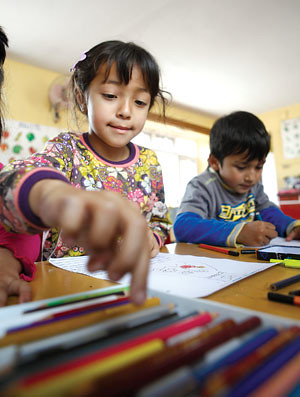With hundreds of preschools to choose from, picking the right fit for your child can be daunting
Admission season is in full swing and like hundreds of other young parents in town you are trying your best to keep up with the merry-go-round: visiting schools, collecting brochures, scanning newspapers, making frantic calls to friends and families for advice. After all, your precocious toddler deserves the best.
Until a decade ago joint families with grandparents, uncles, aunts, and cousins all living under the same roof was the norm in Nepal. Today’s urban parents don’t have that safety net and most work full-time so there is no one at home to take care of the kids. Pressured by an increasingly competitive education system even stay at home mothers (and fathers) are rushing to enroll their children in good preschools which are seen as stepping stones into the formal education system three or four years down the line.

PICS: BIKRAM RAI
No wonder early education has become a highly lucrative business in the country and preschools are mushrooming everywhere, your neighbourhood probably has a couple. Choosing the right fit for your child couldn’t get any tougher.
When Rita Singh started Mickey’s International in 1987, there were only two others in the Valley. That number has grown more than ten folds in the last decade alone. “A simpler registration procedure means that anyone interested in opening a preschool can do it easily. Many have made a business out of it. This was not the case back then,” says Singh.
Spacious play area, safe environment, and well-qualified teachers top most parents’ list of requirement when selecting a preschool. But to keep pace with the intense competition, many of the newer preschools seem to focus on infrastructure rather than quality of teaching. “See whether the teachers are trained or not, go through the school’s curriculum. Don’t look only at the hardware, look at the software,” advices Singh.

I
Another factor most parents tend to overlook is the student-teacher ratio. “Children at this age need individual attention which is not possible if the teacher has to look after a lot of kids at once,” explains Madhu Rai of Sarita Indra Preschool in Biratnagar.
Preschools, however, are no longer just about fun and games. Moving away from the traditional rote learning, preschools today use interactive methods to help children understand the basics of alphabets, numbers, colours, and shapes in an interactive learning environment.

I
Many are also developing ‘ambitious’ curriculums to make sure their students have an edge over their peers. But as long as your four-year-old is learning social and emotional skills, making friends, and building a strong foundation, you shouldn’t worry too much if she cannot recite her multiplication tables yet.
“Children have different thresholds for learning so if they are burdened with too much at once they will stop enjoying the process,” says Hima Pradhan, a psychologist at a high school in Kathmandu, “if you want your children to benefit in the long-term make sure their school engages them in different hands-on activities and gives them plenty of time to play.”
Keeping these in mind, decide on a budget, sit in on a few classes, talk to potential teachers, and pick your top three.